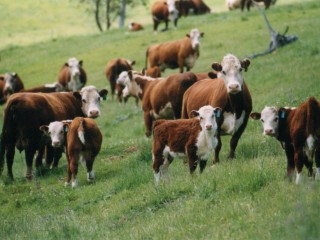 One of the big challenges in cattle selection is that a newborn bull calf born today will not sire his first crop of heifers for five years. It will then be another three years before progeny testing confirms his potential to sire elite daughters.
One of the big challenges in cattle selection is that a newborn bull calf born today will not sire his first crop of heifers for five years. It will then be another three years before progeny testing confirms his potential to sire elite daughters.
But genomics expert, Professor Ben Hayes says some traits, like milk yield in dairy cattle, can only be selected in heifer progeny, and even with artificial-breeding technology such as embryo transfer, a long generation interval constrains the rate of genetic gain.
But he says genomic selection will soon allow breeders to confirm, even before a male embryo is implanted in its surrogate mother, that most of its daughters will be elite milk producers.
Dr Hayes, from the Victorian Department of Primary Industries’ Biosciences Research Division at Bundoora, contributes to genomics research in each of the Beef, Dairy and Sheep CRCs.
He told a recent Livestock Genomics conference in Melbourne that genomic selection would allow breeders to take eggs harvested from that bull’s three-month old daughters, fertilise them in vitro with semen from another elite bull, and select female embryos with even higher milking potential than their mothers.
Dr Hayes described how genomic selection is already accelerating the rate of genetic gain for selected traits in livestock well beyond the incremental improvements from centuries of traditional breeding.
In the past, breeders had pursued improvement by selecting visible or measurable traits, without knowing which genes contribute to traits of interest.
Different variants of the same gene determined whether an Angus would be red or black, or whether an animal would have horns or not. Simple rules govern the inheritance of single-gene traits.
But single-gene traits are the exception to the general rule that most important production traits are polygenic: that is, many genes – tens to hundreds, in some cases – acting in concert, contribute to a greater or lesser degree to commercially important production traits like weight gain, milk yield, beef tenderness or parasite resistance.
Superior genes
The aim of genomic selection is to identify superior variants of all the genes that contribute to important production traits, and bring them together in breeding lines in as few generations as possible.
“When combined with advanced reproductive technologies, genomic selection promises to deliver, over the next few decades, productivity gains that might have taken centuries to achieve with traditional selection,” Dr Hayes said.
The accelerated genetic gains achievable through genomic selection depended on progress made through traditional selection, and how easily progress could be made for commercially important traits in the species of interest, he said.
“If the only trait in a breeding objective was growth rate or ear length, then genomic selection provides little advantage over genetic selection,” he said.
Genomic selection valuable for complex traits
But for traits like female reproductive performance or food-conversion efficiency, genomic selection offered substantial advantages, including its unique power to assess male genetic potential for sex-specific traits like calving rates that can only be measured in females.
Dr Hayes said the dairy industry was the most advanced in applying genomic selection, because a single breed, the Holstein Friesian, dominated production.
“With genomic selection, the accuracy of the breeding value is much higher at an earlier age than it is with traditional breeding. So the dairy industry can use accurate data for milk production even before heifers are ready to breed at two years of age.”
Dr Hayes said it was more difficult to see where genomic selection could increase the rate of genetic gain in meat sheep breeds, where the main trait under selection is eye muscle area.
With traditional breeding methods, eye muscle area could be scanned before breeding age, and it was a fairly accurate predictor of eye muscle area at maturity. Therefore, there was less opportunity to make gains by reducing the breeding interval.
Yet genomic selection still offers the possibility of a 30 per cent extra gain.
“There are some other opportunities, such as number of lambs weaned, where you do not get very good information about breeding values until rams are much older,” he said.
“The other opportunity in meat sheep and beef cattle is to get into breeding based on objective traits – with eye muscle area, you’re actually trying to predict lean meat yield in sires and their progeny. The opportunity for genomic selection lies in being able to select directly for lean meat yield, which can be accurately measured,” Dr Hayes said.
Genetic gain increase of 30pc
“There is an opportunity to increase genetic gain by around 30 percent, but a very large reference population needs to be genotyped and measured to identify all the genetic variation contributing to lean meat yield,” he said.
Dr Hayes said the opportunity for increased genetic gain over traditional selection was around 40pc for beef cattle, with the rate of gain depending on the breeding objective. “For traits like feed conversion efficiency or intramuscular fat, which are difficult to measure, there is potential for genomic selection to deliver quite large gains,” he said.
“In all livestock species, we are trying to significantly increase our rates of genetic gain. To do that, we need more phenotypic data (accurate measurements of traits on thousands of animals) so we can determine how particular genes, and different variants of those genes, influence the production traits that interest us."
“We need to present convincing arguments to each industry – especially the stud sector – about the value of genomics technology and measurements on their animals. To do that, we have to bundle pedigree and performance information with mate allocation options, and genomic breeding values.”
Breeding elite animals faster: how it works
 Imagine that each of the 24,000-odd genes in the cattle genome is identified by a unique barcode, imprinted into the DNA strand in close proximity to each gene – or within the gene itself.
Imagine that each of the 24,000-odd genes in the cattle genome is identified by a unique barcode, imprinted into the DNA strand in close proximity to each gene – or within the gene itself.
Unless they become separated when genes are reshuffled and repackaged in unique new combinations in eggs or sperm, each gene will be inherited with its identifying barcode, so geneticists can track commercially desirable variants of each gene as they are passed from parents to progeny.
A genome-wide association study (GWAS) scans the genome to identify bar codes that consistently occur in the fastest-growing animals, but not in slow-growing animals. These bar codes mark all gene variants that contribute to a gain in productivity, or some other desirable trait.
In a hypothetical example, the GWAS identifies 15 unique bar codes marking chromosomal ‘neighbourhoods’ that harbour 15 as yet-unidentified genes that make important contributions to increased growth rate.
Progeny testing shows one of the genes – call it Gene X – is an important influence on growth rate. Genome scans identify 10 different alleles (variants) of Gene X in the beef cattle gene pool, of which three significantly boost growth rates. In sporting terms, these are the gold, silver and bronze alleles of Gene X.
Geneticists can now design a breeding program to increase the odds that seedstock animals will inherit some combination of these commercially valuable alleles of gene X.
But the genome-wide association study has identified 14 other barcodes elsewhere in the genome marking genes that, in concert with Gene X, influence growth rate. Each gene has multiple alleles, but again, only a few elite alleles significantly boost growth rate.
The aim of the game of genomic selection is to design breeding programs that will bring together as many gold, silver and bronze variants of these growth-boosting genes as possible, in as few generations as possible.
By shortening the long generation interval in cattle, assisted reproduction technologies can carve decades off the time required to develop elite breeding lines.
